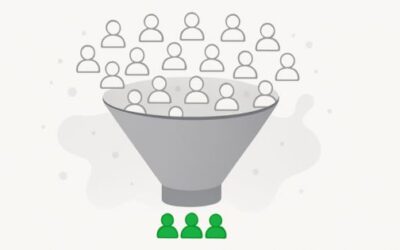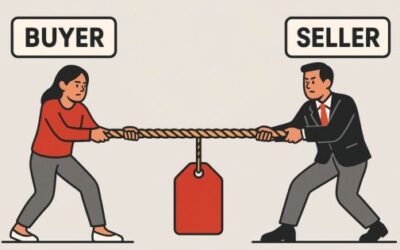CRM: More Than Just a Management Tool
Yeah, I get it.
Most of you think the CRM is a waste of time. Most of you think the CRM just slows you down and that it’s a pain in the ass. You see it as something that benefits management, and you get sick and tired of the sales manager asking, is it in the CRM?
I feel you.
The problem, however, isn’t the CRM. It’s you and how you use it. You aren’t using it correctly. You’re approaching it the wrong way.
If used correctly, the CRM is the by far the best tool you have to manage the entire sale, from contact to contract and therefore make you a better salesperson.
My First Encounter with a Sales CRM
I remember my first sales job. It was 1996. I was an account executive for The Denver Metro Chamber of Commerce. My job was to sell chamber memberships to Denver area businesses. The cost of joining the Chamber ranged from $325 to $10,000. My job was to cold call businesses around the city to highlight the value of a chamber membership to their business and business growth.
In 1996 e-mail was JUST beginning to be a thing. The internet was just beginning to be a thing. There was no texting. There was no LinkedIn, Facebook or any other social media site. But even crazier, there was no Saleforce.com. Act was the CRM of the time. There was also Goldmine (a shout out to my boy and Goldmine founder Jon Ferrara), but that was it. The Chamber didn’t have either of these fantastic CRM’s. We were given an application called File Maker Pro and told to build our own CRM. Yup, I had to create my own CRM with a rudimentary database application.
Being my first job, and not very computer savvy, I took a look at what the other reps had built for themselves and copied that. They all had the expected fields, contact name, phone, address, notes section, next call, etc. But that’s about it. I remember, most of the reps self-built CRM’s were nothing more than a glorified contact list.
What did I know? It was my first sales job. It seemed good enough for me. I copied theirs and jumped in.
It didn’t take long for me to realize it wasn’t nearly enough.
A New CRM: Evolving a Simple Tool into a Powerhouse
To be good at the at job required lots of cold calling, I mean lots. It was 90% of the job. You wouldn’t make quota unless you made the calls and set up the meetings. I wouldn’t call it a sweat shop. However the more aggressive you were with your calling, the more successful you’d be. Unfortunately, with all the calling, it quickly became apparent to me that I couldn’t keep it all straight with the current contact centric, self-made CRM. I needed more.
Over the following year, I continued to customize my CRM to help me win deals and stay on top of opportunities. I created fields to remind me to follow up on cold calls where I left a message. I created fields to remind me to follow up after I sent out information on the Chamber. I created fields that helped me understand their buying motivations. I created fields to track my next steps and deal strategy. I created fields to highlight the product or offering they were considering. I created field after field to better manage the sale and improve my chance of closing the deal and letting nothing slip through the cracks.
What’s most notable about this, is because everyone’s CRM resided on their computer, there was no “network, ” and each one was custom made, management never saw our CRM. It wasn’t a tool for them. They had no or little visibility into our CRMs. They were for us and strictly for us, not management reporting.
My CRM became by best friend. Because of it, I set countless sales records at the Chamber, including largest single sale, biggest month, etc. and my CRM was at the center of it all.
Embrace the CRM
If you want to get better at sales, start learning to use the CRM as a selling tool. Stop looking at the CRM as a form of management compliance. A well used and managed CRM will fundamentally change how you sell. It will shorten sales cycles, increase average deal sizes, keep you from hanging on to opportunities too long, and keep things from falling through the cracks.
The best approach to using the CRM is customizing it to your selling methodology. If you can’t add new fields, you can certainly use the fields that exist to capture the information you need to sell better and offer your buyers a better selling experience.
To use the CRM to sell better there are some required fields or data types that you need to capture in the CRM to make it your friend and help you sell better.
11 Key Customer Relationship Management (CRM) Fields
If you want to sell better make sure you’re using the CRM to capture the following:
The intrinsic motivation of your buyer
Why does the buyer want to buy? If you don’t know why your buyer needs to change, you’re wasting your time selling. Always add why all the stakeholders want to change. (Great post on this here.)
The business problem(s) the buyer is struggling with
You must document exactly what the business and technical issues the buyer is trying to eradicate. The buyer issues and problems must be captured in the CRM in the most robust, buyer specific terms. It must be defined or quantified and documented as such. It can’t be vague or high-level. Inevitably you will come back to this through out the sale. Don’t skimp here, be thorough.
The next yes (or next sale with in the sale)
An opportunity can not be won without a series of little sales. Little sales are the commitments buyers make to move the sale along. It can be a willingness to meet in person, willingness to do a trial or agree to introduce you to the CEO. You must know at every stage of the sales process what your next yes is and it must be documented in the CRM. ‘Cause, that’s the only thing you should be working on.
Your deal strategy
Every deal must have a deal strategy. Your deal strategy is your approach or method for ensure you win the sale. Your deal strategy needs to be in the CRM for you and everyone else to see and read.
Next steps
Many sales reps do manage this in their CRM, and that’s a good thing. The key with next steps is to be very clear what it is you’re asking the buyer to do and what you need to do to make that happen.
A robust description of the current state
The current state is what’s going on now in the account. I call it the editorial. It’s the robust description of what’s happening in the account today. What’s working, what’s not working. Why is the organization struggling? What’s wrong with the current process? How’s their business being affected? How long has it been going on? What are the key metrics and how are they being impacted, etc? The more robust the current state is documented, the higher the probability of close.
A description of the future state
The future state is the vision or hope of the buyer once they’ve fixed everything and gone with your solution. The future state is what the buyer wants to accomplish. Make sure the future state is clearly documented in the CRM. Again, you’re going to want this through out the sales process. Make it robust, quantifiable, and measurable. It will be your best friend if they go dark.
Key Influencers and their unique motivations
In addition to your buyer, you need to document the entire stakeholder team and their buying motivation. Who’s involved in influencing the decision and what’s their motivation?
Tasks
This one is obvious for most of you, but I still get surprised. Make sure all your tasks are time bound and have reminders. It’s too easy to lose track of deals and not stay on top of them without calendar reminders. For EVERY opportunity, there should be a scheduled task that you’re working on with a reminder and a delivery date.
Accurate close dates
Make sure all your opportunities have accurate close dates. This is as much for you as it is for management. You should be able to run a report and determine if you have enough opportunities to make quota.
Accurate deal sizes
All your deal sizes need to be documented and accurate. No guessing! Like close dates, you want to be able to run a report to determine if your pipeline is healthy and
If you want to get better at sales, learn to use the CRM as a tool to better sell. If you want to get better at selling, learn to use the CRM to better position you with your buyers, manage your buyer motivations, overcome objections, create deal strategies, and address blockers and champions.
The best sales people know how to use the CRM as a tool for success, not as a data dumping ground. The best salespeople use the CRM like any other tool, to make their jobs easier and to make themselves more efficient. If you want to learn to sell better, learn to use your CRM as a tool. It will make all the difference.








0 Comments